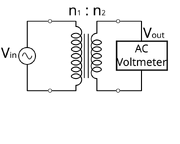Tags: Visual edit apiedit |
m (Reverted edits by 111.88.203.198 (talk | block) to last version by K6ka) |
||
| Line 5: | Line 5: | ||
* n<sub>1</sub>:n<sub>2</sub> |
* n<sub>1</sub>:n<sub>2</sub> |
||
| + | Transformers can have multiple windings for multiple [[Voltage]]s. Generally it is specified by: |
||
* n<sub>1</sub>:n<sub>2</sub> |
* n<sub>1</sub>:n<sub>2</sub> |
||
* n<sub>1</sub>:n<sub>3</sub> |
* n<sub>1</sub>:n<sub>3</sub> |
||
| Line 10: | Line 11: | ||
==Measuring Voltage to find ratio== |
==Measuring Voltage to find ratio== |
||
[[Image:Transformer voltage measurment.svg|thumb|Symbol of a [[transformer]]]] |
[[Image:Transformer voltage measurment.svg|thumb|Symbol of a [[transformer]]]] |
||
| − | A transformer |
+ | A transformer converts one [[alternating current|AC]] Voltage to another. So inputing an AC Voltage and measuring the output Voltage will give you the turns ratio. |
* V<sub>in</sub>/V<sub>out</sub> = n<sub>1</sub>:n<sub>2</sub> |
* V<sub>in</sub>/V<sub>out</sub> = n<sub>1</sub>:n<sub>2</sub> |
||
| Line 19: | Line 20: | ||
==Measuring inductance to find ratio== |
==Measuring inductance to find ratio== |
||
| − | [[Image:Transformer electric symbol inductance.svg|thumb|Measure [[inductance]]]] If you are lucky |
+ | [[Image:Transformer electric symbol inductance.svg|thumb|Measure [[inductance]]]] If you are lucky enough to have an inductance meter ([[LCR meter]]), you can find the inductance of each winding, and the turns ratio. (NOTE: actually, this will not generally work as expected for iron core transformers because of hysteresis effects that will fake out the meter) |
| − | Measure the inductance of |
+ | Measure the inductance of each winding with all other windings open circuit. |
As inductance is proportional to turns squared, then n<sub>1</sub>/n<sub>2</sub> = <sqrt>L<sub>1</sub>/L<sub>2</sub></sqrt> |
As inductance is proportional to turns squared, then n<sub>1</sub>/n<sub>2</sub> = <sqrt>L<sub>1</sub>/L<sub>2</sub></sqrt> |
||
Latest revision as of 23:07, 2 November 2016

Symbol of a transformer
The turns ratio of a transformer is the ratio of number of windings of each side of the transformer. Sometimes you wish to find out the turns ratio of an unlabeled transform.
The transformer turns ration is labeled as follows:
- n1:n2
Transformers can have multiple windings for multiple Voltages. Generally it is specified by:
- n1:n2
- n1:n3
Measuring Voltage to find ratio

Symbol of a transformer
A transformer converts one AC Voltage to another. So inputing an AC Voltage and measuring the output Voltage will give you the turns ratio.
- Vin/Vout = n1:n2
Something to be cautious about is creating too high of a voltage, for the insulation of the wire in the winding. This will cause a short, and bad news. For instance, say you input 120V and the turns ratio is 1:100, then the output would be 12kV
The best method is to get a low voltage AC source and connect it to the wires with the most windings. If the output Voltage is too low to get an accurate measurement, then you just add a higher Voltage.
Measuring inductance to find ratio

Measure inductance
If you are lucky enough to have an inductance meter (LCR meter), you can find the inductance of each winding, and the turns ratio. (NOTE: actually, this will not generally work as expected for iron core transformers because of hysteresis effects that will fake out the meter)
Measure the inductance of each winding with all other windings open circuit.
As inductance is proportional to turns squared, then n1/n2 = <sqrt>L1/L2</sqrt>